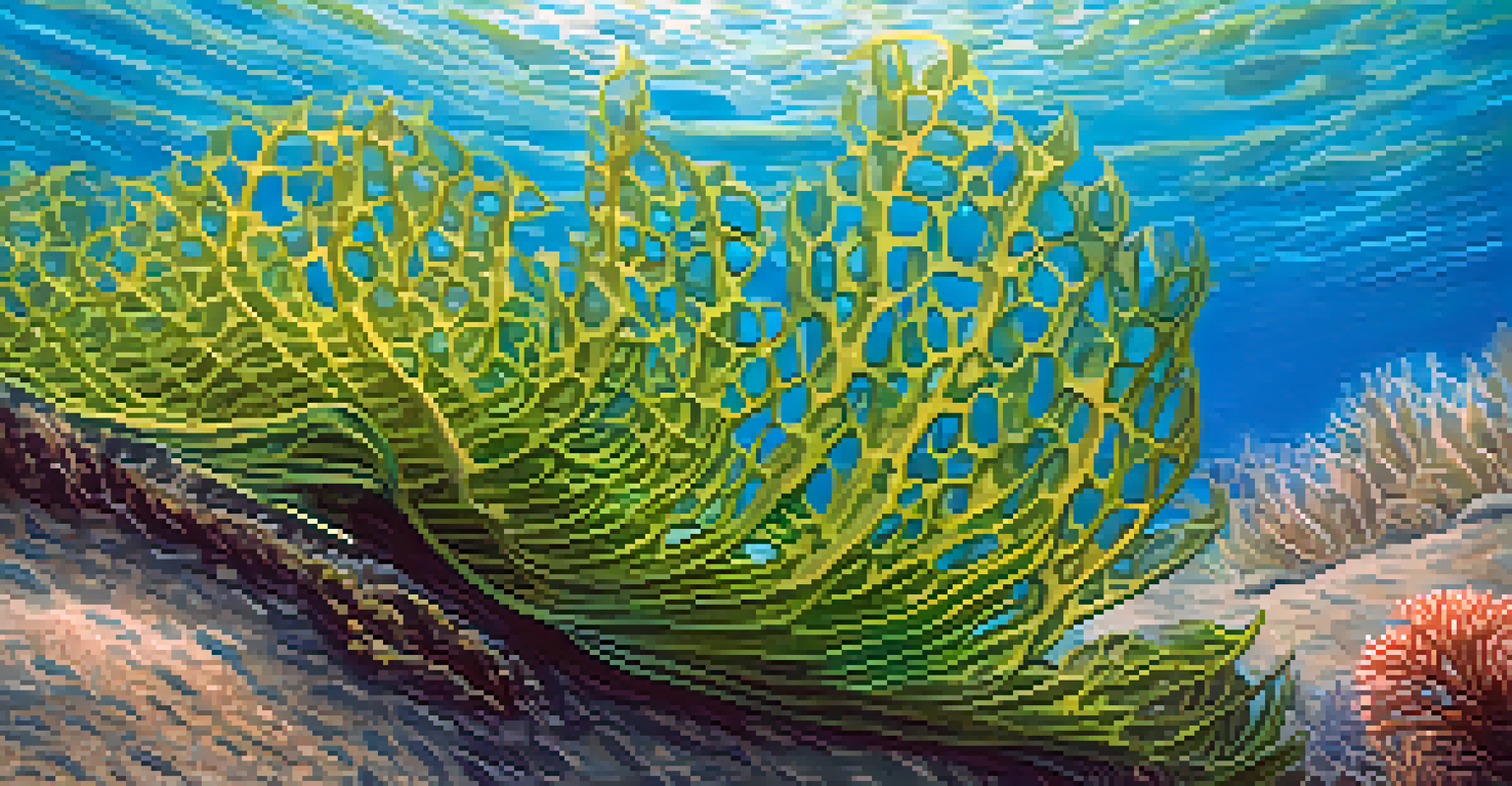The Importance of Kelp Forests in California's Marine Biodiversity

Kelp Forests: An Overview of Their Unique Ecosystem
Kelp forests are underwater habitats formed by large brown algae, primarily kelp, thriving in nutrient-rich coastal waters. In California, these forests create a vibrant ecosystem that supports an array of marine species. Much like a lush forest on land, kelp forests provide shelter, food, and breeding grounds for various organisms, from fish to invertebrates.
Kelp forests are the rainforests of the ocean. They provide habitat, food, and shelter for countless species, forming one of the most productive ecosystems on our planet.
These underwater forests can grow up to 100 feet tall, creating a canopy that provides shade and a unique environment for many marine creatures. The complex structure of kelp forests offers a haven for juvenile fish, crabs, and other small marine life, helping to maintain biodiversity. Without these forests, many species would struggle to survive, as their life cycles are intricately linked to this habitat.
In addition to supporting marine biodiversity, kelp forests also play a crucial role in carbon sequestration, helping to mitigate climate change. By absorbing carbon dioxide from the water, they contribute to healthier ocean ecosystems. Thus, kelp forests are not just beautiful underwater landscapes; they are vital components of a balanced marine environment.
Biodiversity Hotspots: The Life Within Kelp Forests
Kelp forests are often referred to as biodiversity hotspots, hosting a myriad of species. In California, these forests are home to over 800 species of marine life, including fish, sea otters, and various invertebrates. This incredible diversity is essential for maintaining the ecological balance, as each species plays a role in the food web.

For example, kelp serves as a food source for herbivorous fish and sea urchins, while larger predatory fish, birds, and marine mammals rely on these smaller creatures for sustenance. The interactions among these species create a dynamic ecosystem where energy flows from the bottom to the top of the food chain. This interconnectedness highlights the importance of preserving these habitats.
Kelp Forests Support Marine Life
Kelp forests provide essential habitats for over 800 marine species, contributing to biodiversity and ecological balance.
Moreover, the presence of diverse species helps to stabilize the ecosystem, making it more resilient to environmental changes. When biodiversity is high, ecosystems can better withstand disturbances such as climate change, pollution, and overfishing. Therefore, protecting kelp forests is crucial not just for the species that inhabit them, but for the overall health of marine ecosystems.
The Role of Kelp Forests in Fisheries and Local Economies
Kelp forests are not only vital for marine biodiversity; they also significantly contribute to local fisheries and economies. Many commercial fish species, such as rockfish and halibut, rely on kelp forests for shelter and breeding. By providing a rich habitat for these fish, kelp forests support fishing industries that are integral to California's coastal communities.
The health of our oceans directly impacts our communities. Protecting kelp forests is not just an environmental issue; it's an economic necessity.
In addition to fisheries, kelp harvesting plays a role in local economies. Kelp is used in various products, including food, cosmetics, and fertilizers. This sustainable harvesting can provide livelihoods for coastal communities while ensuring that the kelp forests continue to thrive and provide essential ecosystem services.
However, the health of these kelp forests is directly tied to the health of the fishing industry. Overfishing and habitat degradation can lead to declines in fish populations, which in turn affects local economies. Therefore, sustainable management of both kelp forests and fisheries is crucial for maintaining the economic benefits they provide.
Threats to Kelp Forests: Understanding the Challenges
Despite their importance, kelp forests face numerous threats that jeopardize their health and sustainability. Climate change, pollution, and invasive species are among the primary challenges these ecosystems encounter. Rising ocean temperatures can lead to kelp decline, as warmer waters can inhibit kelp growth and contribute to the spread of harmful algal blooms.
Additionally, pollution from urban runoff introduces toxic substances into the marine environment, further stressing these vital habitats. Invasive species, such as the purple urchin, can decimate kelp populations by overgrazing, leading to what is known as 'urchin barrens'—areas devoid of kelp and biodiversity. These challenges highlight the urgent need for conservation efforts.
Economic Benefits of Kelp Forests
These underwater ecosystems play a crucial role in supporting local fisheries and economies through sustainable harvesting.
To combat these threats, researchers and conservationists are working together to develop strategies for restoring and protecting kelp forests. Initiatives such as marine protected areas and restoration projects aim to mitigate the impacts of climate change and invasive species while promoting sustainable practices. Protecting these ecosystems is crucial for the continued health of California's marine biodiversity.
Conservation Efforts: Protecting California's Kelp Forests
Conservation efforts are key to preserving California's kelp forests, and various initiatives are already underway. Organizations, scientists, and local communities are collaborating to create marine protected areas (MPAs) that limit human activities in critical habitats. These MPAs play a vital role in allowing ecosystems to recover and thrive, providing a safe haven for marine life.
Moreover, kelp restoration projects have gained momentum, focusing on replanting kelp and managing invasive species. For instance, organizations are actively removing purple sea urchins to help rejuvenate kelp populations in affected areas. These hands-on efforts not only aim to restore the natural balance but also engage local communities in the conservation process.
Public awareness and education are also essential components of conservation efforts. By informing the public about the importance of kelp forests, individuals can become advocates for their protection. Citizen science initiatives allow people to participate in monitoring and restoration efforts, fostering a sense of stewardship and connection to these vital marine ecosystems.
The Importance of Research in Kelp Forest Conservation
Research plays a pivotal role in understanding the complexities of kelp forest ecosystems and the threats they face. By studying the interactions between species and their environment, scientists can identify key factors that influence kelp health and resilience. This knowledge is crucial for developing effective management strategies that address the challenges kelp forests encounter.
Moreover, research helps track the effects of climate change on kelp forests, providing valuable data that can inform policy decisions. For example, understanding how changing ocean temperatures impact kelp growth can guide conservation efforts and help predict future changes in these ecosystems. This evidence-based approach is essential for ensuring the long-term sustainability of kelp forests.
Threats to Kelp Ecosystems
Kelp forests face significant challenges from climate change, pollution, and invasive species, necessitating urgent conservation efforts.
In addition to ecological studies, research also focuses on community engagement and education. By involving local communities in scientific initiatives, researchers can foster a deeper understanding of kelp forests and their significance. This collaborative approach not only enhances conservation efforts but also empowers individuals to take action for the protection of these vital ecosystems.
Conclusion: The Future of Kelp Forests and Marine Biodiversity
Kelp forests are essential to California's marine biodiversity, providing habitat, food, and economic benefits. However, they face numerous threats that require immediate attention and action. By understanding the importance of these ecosystems and the challenges they face, we can work collectively to protect and restore them for future generations.
Conservation efforts, research, and community engagement are crucial for ensuring the health of kelp forests. It is vital to promote sustainable practices and support initiatives that prioritize the preservation of these underwater ecosystems. By doing so, we not only safeguard marine biodiversity but also help mitigate the impacts of climate change.

As we look to the future, the vitality of California's kelp forests will depend on our commitment to their protection. Together, we can ensure that these rich underwater ecosystems continue to thrive, providing invaluable benefits to marine life and coastal communities alike.